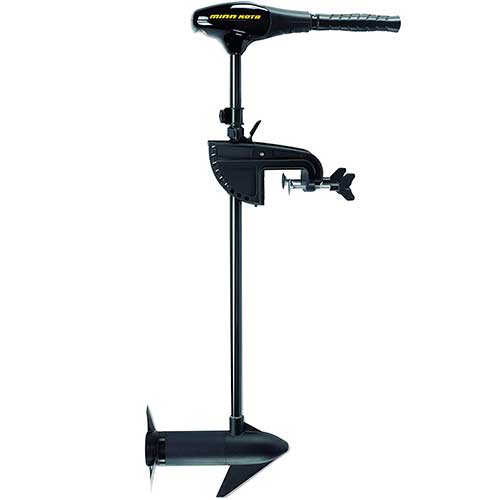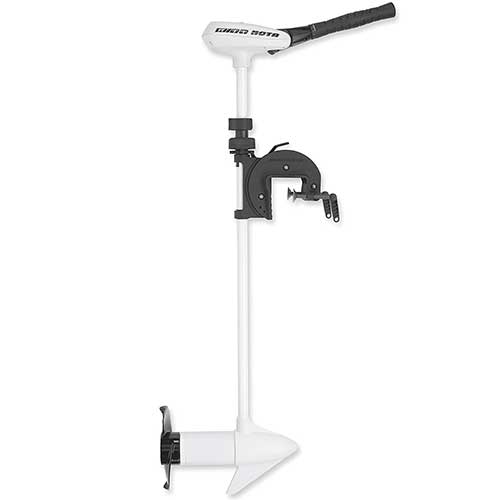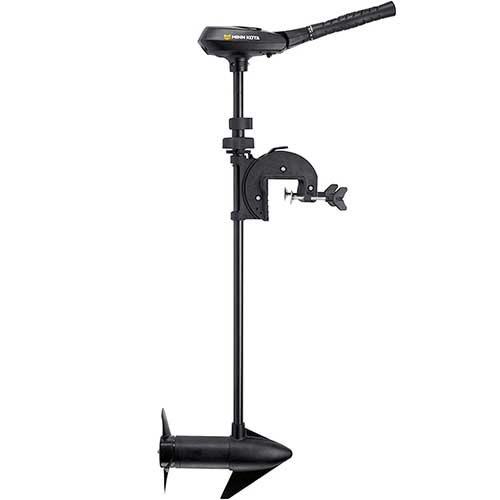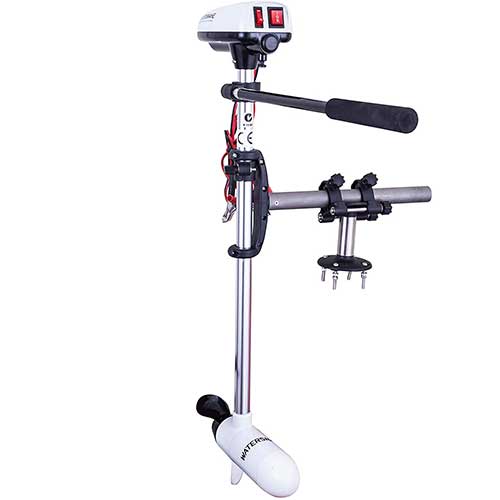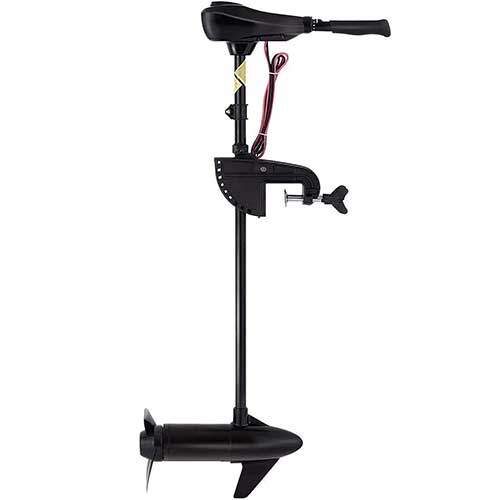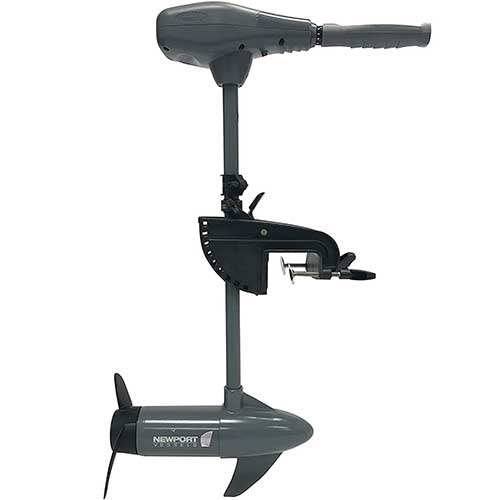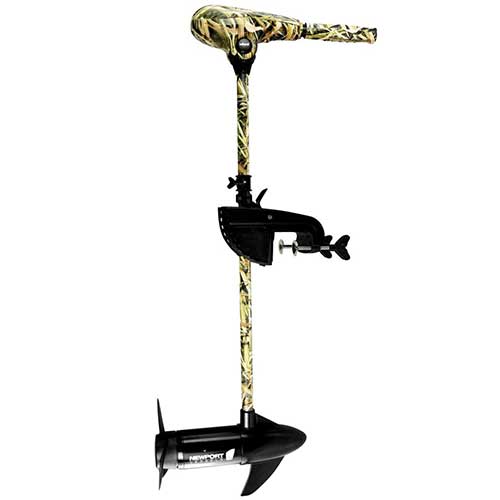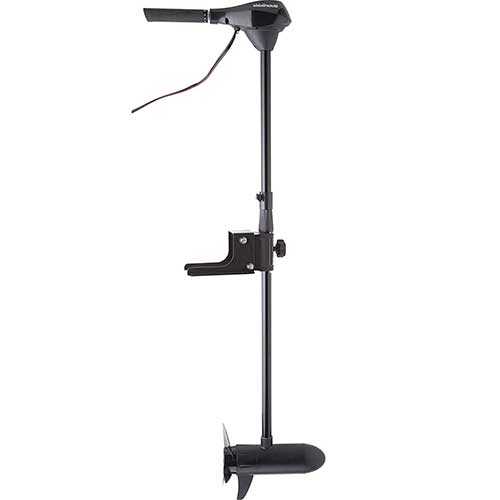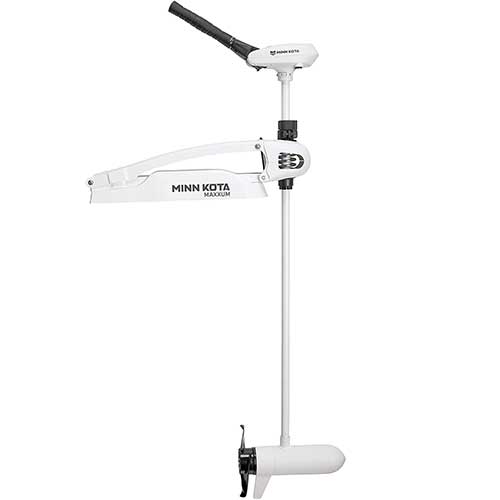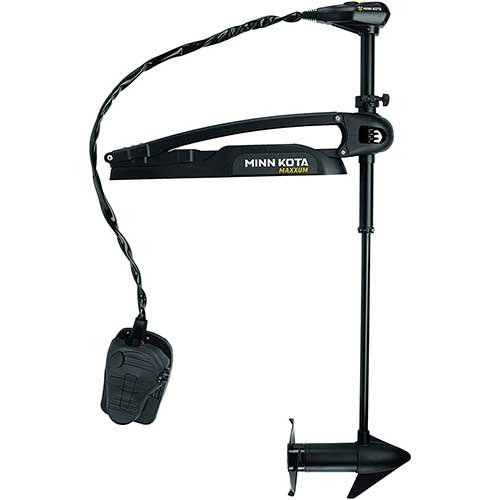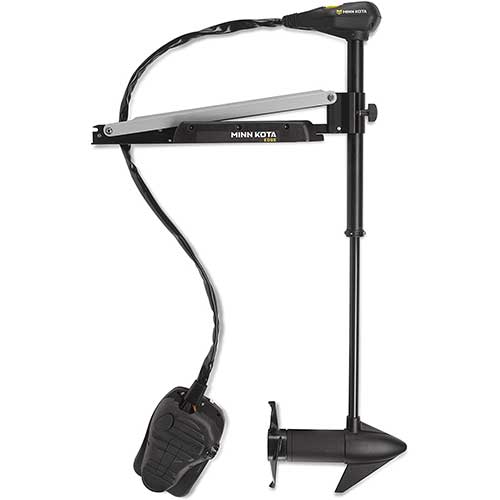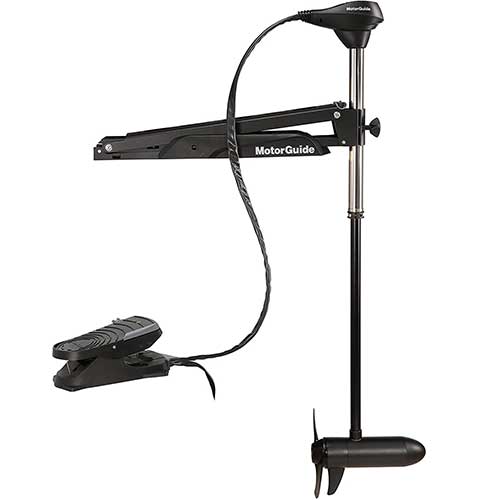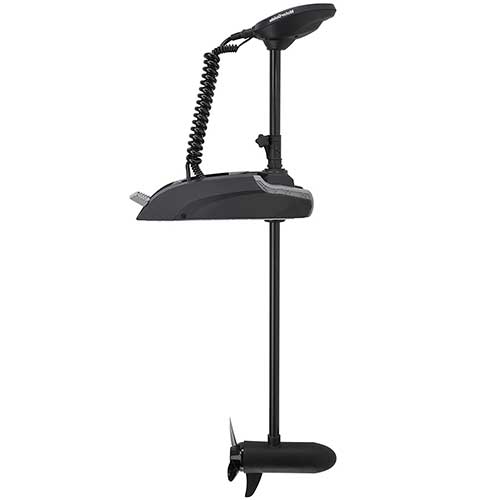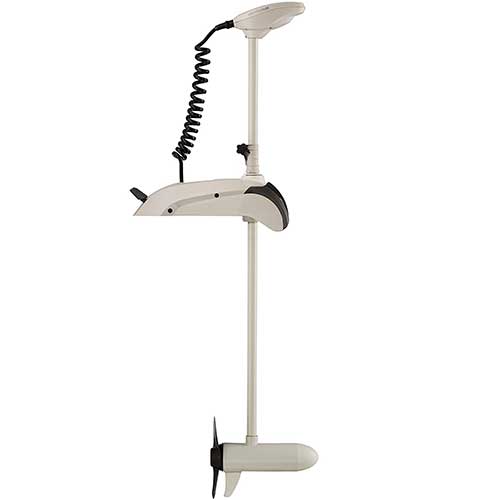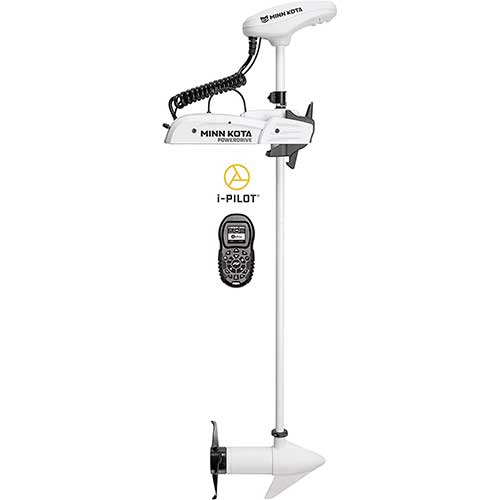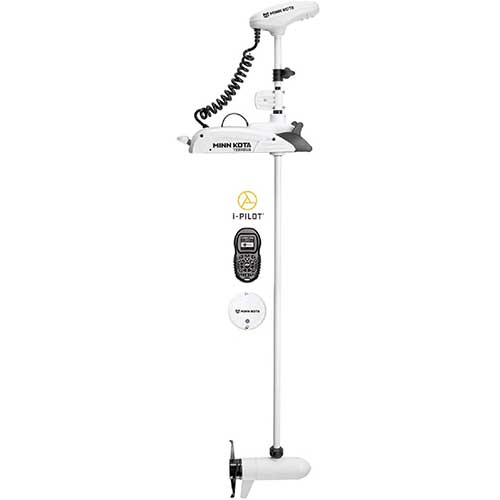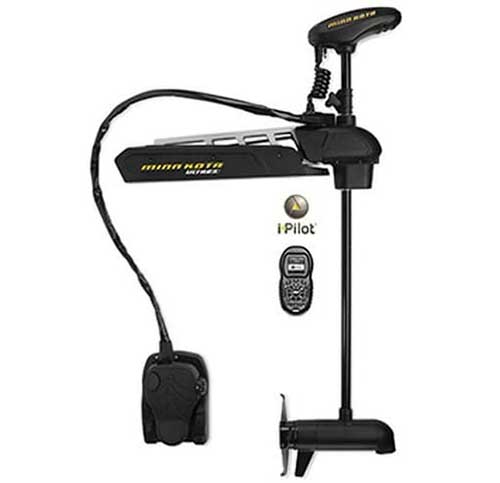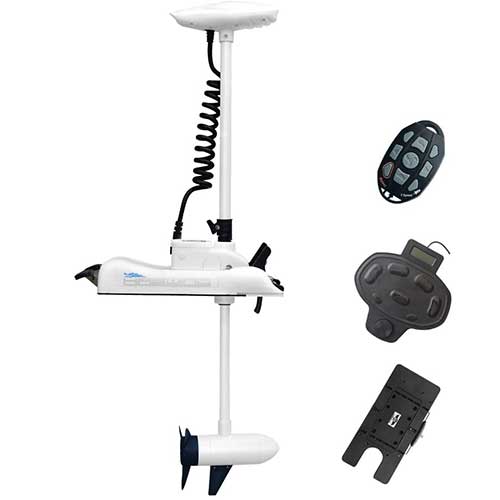Trolling motors are a great way to power a small johnboat, canoe, or kayak. Larger pedal-operated trolling motors are used extensively on bass boats and shallow ocean running boats to fish near the shore. A trolling motor allows the boat to quietly sneak into the best fishing spots.
Without a trolling motor, fishermen have to rely on drift fishing. This is a big disadvantage because the boat is simply taken in the direction of the wind and current. Sometimes the boat ends up in shallow water that is difficult to navigate out of with the large primary motor.
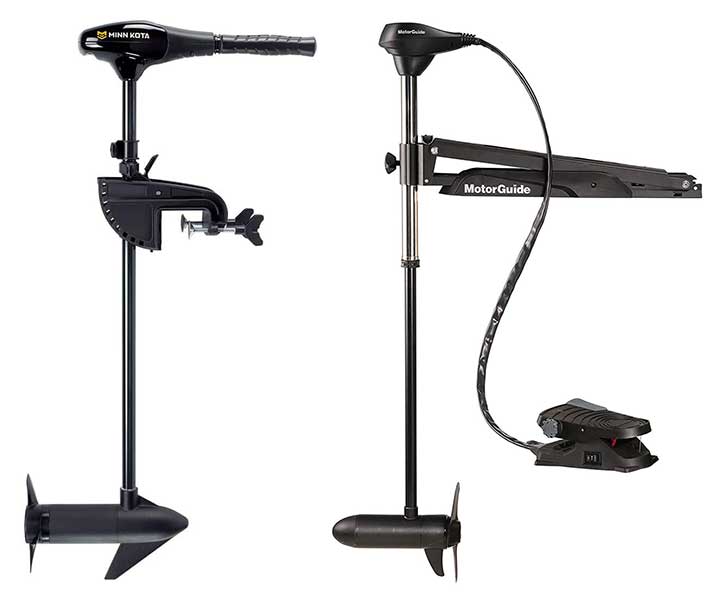
There are several important decisions that will have to be made when selecting a trolling motor. First deciding how much thrust will be needed to propel the vessel is important. Next how it will be mounted. The mounting option for trolling motors includes bow-mounted, transom-mounted, and primary motor mounted. Control options for trolling motors include hand-controlled, cable steered, cable controlled, and technologically controlled.
The power supplied to the motor is delivered by electric batteries. These batteries need to have the proper voltage and current. The amount of current stored in the batteries is measured in amp-hours. The larger the battery’s capacity the longer the motor can be run without being recharged.
The voltage requirement varies based on the max thrust of the motor. Trolling motors with 55 pounds of thrust and under can use a single 12-volt battery. The second level of motors with 60-80 pounds of the thrust recommends using 24 volts requiring two batteries. For large motors with 90-112 pounds of thrust, it is recommended to have 36 volts of power requiring three batteries.
Here Are the Best Electric Trolling Motors
Transom Mount Trolling Motors
1. Minn Kota Endura
| Estimated Price | $115-$260 |
| Thrust Levels | 30, 40, 45, 50, or 55 |
| Control | Telescopic Tiller |
| Speeds | 5 Forward, 3 Reverse |
| Voltage | 12 Volts |
| Shaft Lengths | 30, 36, or 42-Inch |
| Saltwater Rated | No |
Minn Kota has several top-selling trolling motors for pretty much every scenario and watercraft type. The Minn Kota Endura is a transom-mounted unit sporting five different thrust options which are 30, 40, 45, 50, and 55 pounds.
The shafts lengths vary based on the distance the motor is mounted in the water. The shaft length also affects the handle height. If the boat is controlled while sitting down a lower handle height is good. When controlling to motor from a standing position a taller handle height is better. Shaft lengths are 30, 36, and 42 inches. The handle of this unit is telescopic to make it longer or shorter based on the situation.
The Minn Kota composite shaft is well known for its incredible durability. It is true that it can significantly bend but it won’t break. These motors can take some abuse without having major issues.
This is an excellent trolling motor for anglers that want a basic reliable transom mount trolling motor using a single 12-volt battery. Minn Kota offers a lifetime warranty on the shaft and a two-year limited warranty on the rest of the package.
2. Minn Kota Endura Max Transom Mount Trolling Motor
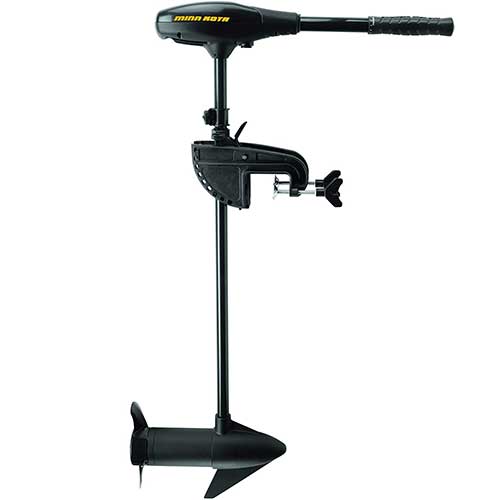
| Estimated Price | $240-$310 |
| Thrust Levels | 40, 45, 50, or 55 |
| Control | Telescopic Tiller |
| Speeds | Digital Maximizer |
| Voltage | 12 Volts |
| Shaft Lengths | 30, 36, or 42-Inch |
| Saltwater Rated | No |
This unit is almost entirely the same as the regular Endura but comes with the Digital Maximizer system. The difference in price is roughly $50, and some of you may not need the Digital Maximizer on the Endura Max so that is why both of the trolling motors are on the list.
The Digital Maximizer is a software that automatically adjusts the power supplied to the trolling motor based on a predetermined speed. This can in theory increase your battery life by 5 times in certain situations. Trolling motors do not necessarily make the boat go faster by applying more power. The pitch of the prop limits how fast a trolling motor will go. The maximizer helps ensure the user is not running the motor faster than is needed. This is most helpful when traveling from one location to another with the trolling motor.
3. Minn Kota Riptide SC Transom Mount
| Estimated Price | $310-$520 |
| Thrust Levels | 45, 55, or 112 |
| Control | Tilt Extending Tiller |
| Speeds | 5 Forward, 3 Reverse |
| Voltage | 12V for 55, 65, 36V for 112 |
| Shaft Lengths | 36, 42, or 52-Inch |
| Saltwater Rated | Yes |
The Minn Kota Riptide SC is a transom mount saltwater-rated trolling motor that is controlled with a tiller handle. Features include the indestructible composite shaft, push to test battery life indicator, quiet motor, and a 10 position bracket that adjusts with a quick-release lever. The SC version has 5 forward speeds and three reverse speeds. The other type is continuous variable speed.
The tiller handle extends 6 inches and can tilt up to 45 degrees. The shaft has a lifetime warranty and the unit has a two-year limited manufacturer warranty.
4. Minn Kota Vantage Freshwater Trolling Motor
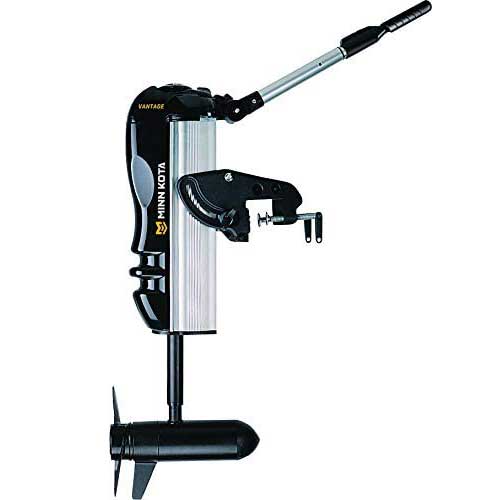
| Estimated Price | $1,500 |
| Thrust Levels | 80 or 101-Pound. |
| Control | Tilt Extending Tiller |
| Speeds | Digital Maximizer |
| Voltage | 24 Volts, 36 Volts |
| Shaft Lengths | 31-Inch. |
| Saltwater Rated | No |
The Minn Kota Vantage is a powerful trolling motor that is hand steered. The motor is unique in that it can be raised and lowered automatically with the push of a button. It has the vantage mounting system which breaks away on impact which helps protect the boat and motor when striking the ground.
The trolling motor has a 4:1 articulating steering system for sharper turns with less tiller handle movement. It can also turn 180 degrees so the propeller can be used in the more efficient forward motion to travel in all directions. The Vantage can quickly be placed in back trolling mode where the motor is turned 180 degrees.
Features include a tiller handle that can extent 31 inches, digital battery life indicator, and the digital maximizer to control the boat speed more efficiently to extend battery life. It also has the Weedless Wedge 2 propeller which is very popular with anglers who bass fish in the weeds.
5. Minn Kota Traxxis Trolling Motor
| Estimated Price | $395-$450 |
| Thrust Levels | 45, 55, 70, or 80 |
| Control | Tilt Extending Tiller |
| Speeds | Digital Maximizer |
| Voltage | 12 Volts or 24 Volts |
| Shaft Lengths | 36 or 42-Inch |
| Saltwater Rated | No |
The Minn Kota Traxxis unique trolling features are with its steering modes. It is a transom mount trolling motor but the direction the motor faces can be quickly changed 180 degrees to allow for back trolling. This makes the propeller and motor more efficient when back trolling.
It also has a 4:1 articulating steering system where 45 degrees of motion of the tiller handle moves the motor 180 degrees. Other features include the digital maximizer, an indestructible composite shaft that is strong and flexible, and a tilt extending tiller handle. It can be stored and deployed using one hand. This unit comes with a 3-year limited manufacturer warranty.
6. Watersnake with Kayak Bracket Trolling Motor
| Estimated Price | $123-$190 |
| Thrust Levels | 18 or 24-Pound |
| Control | Tiller |
| Speeds | High, Low, and Reverse |
| Voltage | 12 Volts |
| Shaft Lengths | 24-Inch |
| Saltwater Rated | Yes |
The watersnake trolling motor is specifically designed for kayaks. It comes in two configurations a transom mount or a kayak side mount. The two-blade propeller is a weedless design so it will work well when fishing in thick cover. This trolling motor is designed with fishing in mind.
Key features include its lightweight, high-low power switch, forward-reverse switch, and mounting design that will work with most kayaks. There is an Intex Mount Kit that will also allow this trolling motor to be used on small inflatable boats.
7. Goplus Electric Trolling Motor
| Estimated Price | $170-$250 |
| Thrust Levels | 46, 55, and 86-Pound |
| Control | Extending Tiller |
| Speeds | 5 Forward, 3 Reverse |
| Voltage | 12V for 46, and 55, 24V for 86 |
| Shaft Lengths | 36-Inch |
| Saltwater Rated | Yes |
The Goplus is a transom mount tiller controlled electric trolling motor. This is a basic trolling motor and would be good to use on a small Jon boat, kayak, or inflatable boat.
It has a 10 position bracket to lift and lower the motor into different angled positions. The shaft depth can also be adjusted with a clamp which is nice when going into really shallow water. There is also a 10 point LED battery life indicator. The head of the motor is made with aluminum which can increase the life of the unit.
8. Newport Vessels Kayak Series Trolling Motor
| Estimated Price | $180-$250 |
| Thrust Levels | 36 or 55 |
| Control | Telescopic Tiller |
| Speeds | 5 Forward, 3 Reverse |
| Voltage | 12 Volts |
| Shaft Lengths | 24-Inch |
| Saltwater Rated | Yes |
The Newport Vessels Kayak series is a short trolling motor that is built for Kayaks. It is available in either 36-pound or 55-pound thrust options and comes with a 24-inch fiberglass shaft. The shaft length is to short for most boats but can work with inflated boats.
This is purpose-built for kayaks, is economically friendly, and easily propels a kayak with tons of gear. The motor is equipped with anti-corrosion coatings and seals making it resistant to saltwater.
The motor encasement and internals are all crafted from lightweight aluminum and stainless steel. This unit is to be mounted on the rear (transom) of the kayak. It comes with an adjustable handle height and works work most kayak sizes. The motor also comes with a 2-year limited warranty.
9. Newport Vessels Mossy Oak Trolling Motor
| Estimated Price | $190-$260 |
| Thrust Levels | 40 or 55-Pound |
| Control | Extension Tiller |
| Speeds | 5 Forward, 3 Reverse |
| Voltage | 12 Volts |
| Shaft Lengths | 36-Inch |
| Saltwater Rated | Yes |
These Newport Vessels trolling motor comes in Mossy Oak camo or black. Power options are 40 pounds or 55 pounds. Both sizes are powered with a single 12-volt deep cycle battery.
Features include a 30-degree adjustable handle in the vertical direction, a LED battery life indicator, and saltwater rated equipment. This is a transom mount trolling motor with a tilt-adjust mounting bracket. The battery cable is 4 feet in length. A 50 AMP circuit breaker is included and should be installed to help protect against electrical damage.
Bow Mount Trolling Motors
10. Motorguide X3 Bow Mount Hand Control Trolling Motor
| Estimated Price | $392-$605 |
| Thrust Levels | 45 or 55-Pound |
| Control | Extending Tiller |
| Speeds | 5 Forward, 3 Reverse |
| Voltage | 12 Volts |
| Shaft Lengths | 50-Inch |
| Saltwater Rated | No |
This Motor Guide X3 is a bow mount trolling motor with a tiller to control position and speed. Some anglers prefer to use a tiller over a foot pedal or wireless remote. While this is less common it is an effective way to control the boat.
Features include a composite shaft with a lifetime warranty, extendable tiller handle, new mount design, composite locking pins, and quiet 3-blade Machete propeller.
11. Minn Kota Riptide Maxxum Saltwater Trolling Motor with Latch
| Estimated Price | $780-$1,350 |
| Thrust Levels | 55, 70, and 80-Pound |
| Control | Tilt Extending Tiller |
| Speeds | Digital Maximizer |
| Voltage | 12V for 55, 24V for 70 and 80 |
| Shaft Lengths | 52 or 62-Inch |
| Saltwater Rated | Yes |
This is the Minn Kota Maxxum Riptide saltwater trolling motor with latch. It is a bow mount trolling motor that is controlled with a tiller handle. The latch and door make the motor easily removable. It is placed on a Bowguard 360 mount which allows the motor to break free if it runs aground.
This is a Riptide model which means that it is saltwater rated with coated aluminum for corrosion resistance. The digital maximizer helps adjust the motor power to level for a given speed which helps maximize battery life. There is a button to press to display battery life. The depth of the motor can quickly be changed with the quick lock cam depth adjuster.
12. Minn Kota Maxxum Bow Mount Trolling Motor
| Estimated Price | $700-$1,080 |
| Thrust Levels | 55, 70, and 80-Pound |
| Control | Foot Pedal or Tiller |
| Speeds | Digital Maximizer |
| Voltage | 12V for 55, 24V for 70 and 80 |
| Shaft Lengths | 42, or 52-Inch |
| Saltwater Rated | Yes |
The Minn Kota Maxxum is a bow mount freshwater trolling motor. This is the freshwater version of the Riptide Maxxum and comes in a shorter 42-inch shaft length option and has a weedless wedge 2 propeller. The unit can come in the cable food pedal control configuration or the tiller hand-control configuration.
It is mounted on the Bowguard 360 which breaks away if it runs into the ground. After breaking away the unit will automatically reset. The mounting bracket also makes it easy to remove the trolling motor. Features include the digital maximizer, illuminated directional indicator, anodized aluminum mount, and a push to test battery indicator.
13. Minn Kota Edge Bow Mount Trolling Motor
| Estimated Price | $410-$610 |
| Thrust Levels | 45, 55, or 70. |
| Control | Tilt Twist Tiller or Foot |
| Speeds | 5 Speeds |
| Voltage | 12V for 45, 55, 24V for 70. |
| Shaft Lengths | 36, 45, 50, or 52-Inch |
| Saltwater Rated | No |
The Minn Kota Edge is a reasonably priced bow mountable trolling motor. It also comes in two styles, a foot-controlled model and a hand-controlled model. The foot control model is more popular as this leaves both hands free to fish.
The foot control cord is roughly 4 feet in length. It has a latch and door design that makes the motor easy to remove which is often important. The hand control model has a tilt tiller for easy control even when standing. This trolling motor comes with a two-year limited manufacturer warranty and the composite shaft has a lifetime warranty.
14. MotorGuide X3 Bow Mount Trolling Motor
| Estimated Price | $440-$710 |
| Thrust Levels | 45, 55, or 70 |
| Control | Power Prop |
| Speeds | 5 Speeds |
| Voltage | 12V for 45, 55, 24V for 70 |
| Shaft Lengths | 36 or 50-Inch. |
| Saltwater Rated | Yes |
The MotorGuide X3 is a bow mount trolling motor with foot control. It comes equipped with the MotorGuide Proprietary Variable Ratio Steering (VRS) system. This is widely known as one of the most accurate foot-controlled systems in units priced under a thousand bucks.
The entire unit is constructed of aircraft-grade aluminum and uses stainless-steel hardware, making it fairly corrosion resistant and ready to plunge into saltwater. The X3 was built with sound reduction in mind. They utilized composite bushings and locking pins to ensure quiet operation the entire unit is easy to use.
15. Motorguide Tour Pro Trolling Motor
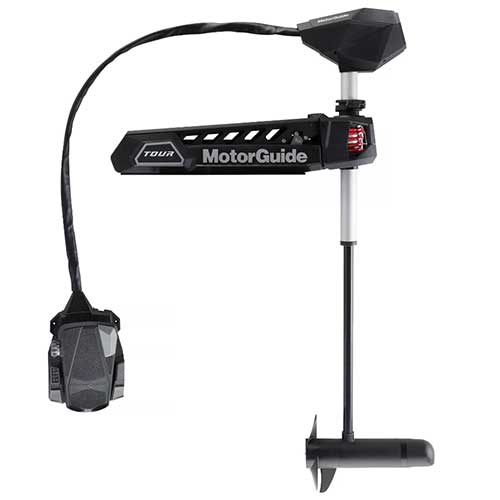
| Estimated Price | $2,700-$2,800 |
| Thrust Levels | 109-Pound. |
| Control | Cable-Steer with GPS Anchor |
| Speeds | Foot Pedal. |
| Voltage | 136 Volts |
| Shaft Lengths | 45-Inch |
| Saltwater Rated | No |
The Motorguide Tour Pro is a powerful freshwater trolling motor commonly used on bass fishing boats. It is the only trolling motor that has the GPS anchor feature with a foot pedal cable steer design. The GPS can connect to most fishing finders.
It has a 3 blade weedless prop that is 30 percent more efficient than older version propellers. The 360-degree breakaway mount helps protect the motor when running to the ground. Other features include Zero-G lift-assist, pinpoint with anchor lock, heading lock, and cruise control.
16. Motorguide Xi3 Wireless Trolling Motor
| Estimated Price | $845-$1,070 |
| Thrust Levels | 55 or 70-Pound |
| Control | Wireless Remote |
| Speeds | Digital Power Management |
| Voltage | 12V for 55 and 24 V for 70 |
| Shaft Lengths | 36, 48, 54-Inch |
| Saltwater Rated | Salt Version Available |
The Motorguide Xi3 comes in black which is the freshwater version and white which is the saltwater version. There are three options to choose from, standard, standard plus GPS, and standard plus GPS with sonar.
All of these units are controlled using a wireless remote control. A wireless foot control pedal is available for the unit but is not included. Features include an efficient quiet motor, GPS to allow a position to be held, a secure step lever for easy deployment, and digital power management to allow the batteries to last longer. The sonar can be integrated with most popular fishfinder brands such as Lowrance and Simrad.
17. Motorguide Xi5 Wireless Saltwater Trolling Motor
| Estimated Price | $1,990-$2,402 |
| Thrust Levels | 55, 80, 105-Pound |
| Control | Wireless Remote |
| Speeds | Digital Power Management |
| Voltage | 12V, 24V, 36V |
| Shaft Lengths | 48, 54, or 72-Inch |
| Saltwater Rated | No |
The Motorguide Xi5 is a trolling motor with wireless operation. It can come with or without GPS. A built-in 83/200 kHz sonar is included and can interface with select Lowrance, Simrad, and Mercury VesselView fish finders.
Key features include Pinpoint GPS, saltwater rated components, high-efficiency electronics, wireless handheld remote control, and digital power management for longer battery life. A wireless foot control pedal is available for this unit but does not come included.
18. Minn Kota Riptide Powerdrive Bow Mount Trolling Motor
| Estimated Price | $950-$1,180 |
| Thrust Levels | 55, or 70 |
| Control | Wireless, GPS, or Foot |
| Speeds | Digital Maximizer |
| Voltage | 24 Volts |
| Shaft Lengths | 48 or 54-Inch |
| Saltwater Rated | Yes |
The Riptide Powerdrive and the Riptide Terrova are very similar in appearance and functionality, but the Terrova is a more expensive and polished product.
The Powerdrive does come equipped with the I-Pilot feature, which is powered by GPS and enables many powerful functions such as spot-lock, autopilot, and is controllable by the I-Pilot handheld remote. Now, the Powerdrive does not allow the use of both a foot pedal and the remote simultaneously, that functionality is reserved for the more expensive Terrova model.
The Powerdrive is deployed by hand, without the use of the Minn Kota deploy assist. If you are not using the I-Pilot function with the remote, you will have to operate the trolling motor by hand. There is no foot pedal integration with the Powerdrive model. This is when many people spend the extra money and get the Terrova model.
The I-Pilot system also allows co-pilot with the use of BlueTooth integration on your smartphone. This allows the driver to make quick and easy adjustments from their phone.
The spot-lock holds a position and is accurate up to 3 feet. It calculates position using GPS and can even account for most wind and wave conditions.
Both Riptide modules are specifically designed for saltwater use. Riptide signifies that the unit is anti-corrosive and suitable for saltwater implementation. If the Minn Kota unit you are looking at doesn’t say it is a Riptide model, it will not come with the proper anti-corrosive coatings.
19. Minn Kota Riptide Terrova Bow Mount Trolling Motor
| Estimated Price | $1,064-$2,500 |
| Thrust Levels | 80-Pound |
| Control | Wireless, GPS, or Foot |
| Speeds | Digital Maximizer |
| Voltage | 24 Volts |
| Shaft Lengths | 54, 60, or 72-Inch |
| Saltwater Rated | Yes |
This Riptide Terrova trolling motor has the same basic functionalities as the Powerdrive with the added features of a foot pedal and lifts assist. This is the Riptide version of the Terrova, which is the version purpose-built for saltwater use and is anti-corrosive.
Another difference here between the Powerdrive and the Terrova is its thrust and shaft options. With the Terrova, the max thrust is 80 pounds compared to 70 pounds with the power drive. The Terrova also has 60 and 72-inch shaft length options.
If your watercraft is on the heavier side or you want the lift-assist feature or you want to control with your feet the Terrova is a better option than the Powerdrive. Both options are great and both have their place based on user needs. If money is not an factor, check out the Minn Kota Ultrex, as it is even more powerful than both of these units and offers some advanced control features.
20. Minn Kota Ultrex I-Pilot Bow Mount Trolling Motor
| Estimated Price | $3,780 |
| Thrust Levels | 80 or 112-Pound |
| Control | Wireless, GPS, or Foot |
| Speeds | Digital Maximizer |
| Voltage | 24V for 80 and 36V for 112 |
| Shaft Lengths | 45 or 52-Inch |
| Saltwater Rated | No |
The Minn Kota Ultrex is widely reviewed and praised by many professional fishermen. It comes with a foot pedal and some of the most advanced control mechanisms on any trolling motor to date.
Key features include the lift assist, large easy to read LCD display, remote control, spot-lock, steering lock, and the most sensitive foot-pad ever found on a trolling motor. It is so sensitive that some people actually complain about it at first as it takes some time to get used to how smooth and easy it is to use!
The I-Pilot feature utilizes GPS functionality for its co-pilot and spot-lock features. It will also record your travels and automatically position your boat within a 3-foot radius. Spot-Lock can also be adjusted in any direction by 5’, allowing easy incremental adjustments.
I-Pilot will also report battery life and estimated time remaining based on real-time data from usage, conditions, etc. Of course, the Ultrex also comes equipped with the Minn Kota Digital Maximizer, which has proven capabilities of increasing battery life up to 5 times compared to units without this feature.
The I-Pilot also has smartphone integration, allowing full access to its controls in the palm of your hand. Some people even use this when taking the boat off the trailer.
Lastly, the Universal Sonar 2 feature is a handy method of mounting a transducer by allowing you to completely conceal the wiring of pretty much any transducer you choose to implement.
21. Aquos Haswing Cayman Bow Mount Motor
| Estimated Price | $670 |
| Thrust Levels | 55-Pound |
| Control | Wireless or Wired Foot |
| Speeds | Digital Control |
| Voltage | 12 Volts |
| Shaft Lengths | 48-Inch |
| Saltwater Rated | Yes |
The Aquos Haswing Cayman is a bow-mounted trolling motor. It comes standard with rechargeable wireless remote control. A wired foot pedal is optional and it has a digital display. There is also a quick-release mount that can add a padlock to prevent people from stealing the motor. Color options are white or black which are both saltwater rated.
This motor can be used on boats that are 18 feet or smaller and weigh up to 2750 pounds. The wireless remote can control the motor up to around 150 feet. Features include an LED battery meter, encapsulated electronics, depth collar to adjust the depth, motor fin, and 360-degree steering.
22. Minnkota E-drive Primary Electric Motor
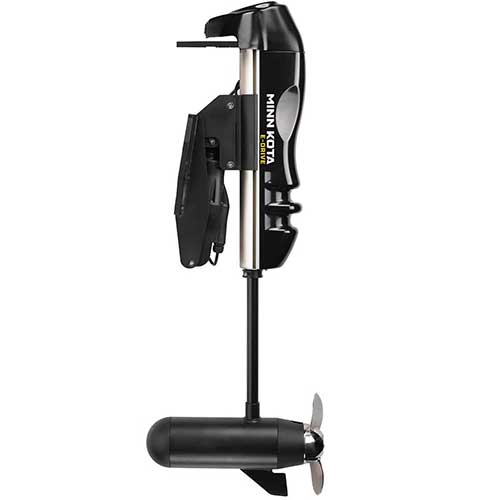
| Estimated Price | $4180 |
| Thrust Levels | 2 HP about 150-Pounds |
| Control | Electric Throttle |
| Speeds | Digital Maximizer |
| Voltage | 48 Volts |
| Shaft Lengths | 20-Inch |
| Saltwater Rated | No |
Minnkota E-drive is set up to act as a primary electric motor. This is a great motor option for fishing boats and pontoon boats on electric-only lakes. The E-drive can push a full-size pontoon boat about 5 miles per hour. It can run for about 2 hours on a full charge. Much longer than two hours at slower speeds.
The motor is rigged with outboard cable linkage to be able to steer from the driver’s seat. It has an electric throttle with forward, reverse, and neutral. The motor can be raised and lowered using the push-button tilt. On the throttle unit, there is a real-time gauge that shows the engine power level and battery life.
The motor is connected with a bolt-on transom mount and has a breakaway system that helps protect the motor in the event it runs into the ground. It has a stainless steel prop with a shear pin that can protect the prop if it hits the ground.
23. Torqeedo Travel 1003 Electric Outboard Motor
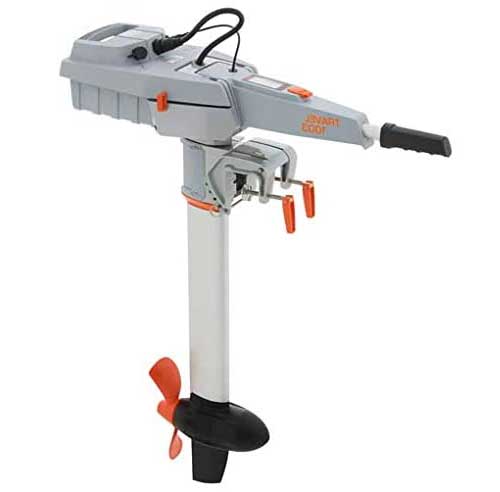
| Estimated Price | $2500 |
| Thrust Levels | 3 HP about 225-Pound |
| Control | Tiller |
| Speeds | Digital Control |
| Voltage | 29.6 Volts |
| Shaft Lengths | 30, 36, or 42-Inch |
| Saltwater Rated | 24.4, or 29.7-Inch |
The Torqeedo Travel 1003 is an electric outboard motor that can be used on sailboats, dingings, and inflatable boats. This motor is rated for boats between 1000 pounds to 3000 pounds. The weight of the motor is 19.6-20.0 pounds, with the batteries the weight is 29.5-30.9 pounds.
A battery does come included with the trolling motor. It is 915Wh and 29.6 Volts. The battery takes about 15 hours to charge. It lasts about 17 hours at 1.25 miles per hour, 6 hours at 2 miles per hour, and 55 minutes at 3 miles per hour. Its potential range is increased at slower speeds in most conditions.
A charger is included with the motor. Lead deep cycle batteries do not work with Torqeedo motors. There is an onboard computer integrated with GPS that will display the battery charge status, range, and speed information. A magnetic stop key is located on top of the unit in the event of and emergency requiring the unit to be stopped immediately.
Electric Trolling Motors
Electric trolling motors are very useful when fishing in shallow water for fish like bass, crappie, and tarpon. Trolling motors are not actually used to troll lures but rather to get into shallow locations quietly and without risking hitting the bottom with the main motor.
Trolling motors are comprised primarily of four basic components. The shaft, the motor, the propeller, and the battery. Each of these has many subsets that will cause variations in the way the trolling motor is utilized and how it will perform. Understanding each of them and choosing a conglomerate of the four that are built for your boat size and your needs is important when shopping for a trolling motor.
A trolling motor is an all-in-one removable unit encompassing a small motor attached to a prop at the end of a shaft. These motors are designed to offer the operator advanced control and precision over their watercraft. Many people use them for fishing in instances of navigating small watercraft without a primary source of power or navigating boats more precisely through difficult obstacles.
For example, one may have an outboard motor attached to their boat, but to fire that up and use it to maneuver around closely packed trees in the water may result in scaring the fish away. It may also cause a few more bumps and rubs against the trees than you would like. Using a trolling motor in this situation keeps the noise level significantly lower than what your full-size motor would produce. At the same time, it allows you to navigate in smaller more precise increments around the trees in the area.
Trolling Motors Applications
Another great example of utilizing a trolling motor is on watercraft which does not have the capabilities of using a traditional motor and prop system. Watercraft such as canoes, kayaks, rowboats, etc will benefit greatly from the use of a trolling motor. Most of us love fishing and therefore would rather use our time and energy on the actual act of fishing itself instead of rowing all day to fish good spots. Using a trolling motor makes it easy to navigate these watercraft.
Many people also keep a trolling motor retracted on their watercraft as a backup option in case their primary source of power becomes damaged or fails. Being stuck in the middle of a lake with a failing motor is never fun, but coming prepared with a trolling motor ensures you get back to the dock safely and timely. Since trolling motors are fairly light, highly durable, and don’t take up much space, it’s rather easy to come prepared with one as an emergency backup.
Another major advantage of using a trolling motor is in situations where wake or gas combustion motors are prohibited. So long as you’re using an electric powered trolling motor, most places will allow this over the use of a gas-powered motor, giving you more options in where you can fish.
Mounting Positions and Configurations
Before we get started on the specific components you should plan for, let’s figure out where we’re sticking our trolling motors. Where you choose to mount your trolling motor will usually depend on your method and type of fishing, your boat construction, and mounting availability.
Furthermore, there are a few more aspects to mention about mounting that you need to consider. Not all mounts are created equally and you generally get what you pay for. Many of the most popular brands of trolling motors will come with a mounting package alongside the trolling motor itself.
Mounts can range in quality and features. For example, some mounts are pretty much permanent installations where your trolling motor would sit in that position and would remain there regardless of using your boat or not. Other mounts offer release mechanisms that allow you to turn a few knobs to release the trolling motor. This allows you to store it somewhere else. Having it in a locked garage helps so someone does not come along and steal your trolling motor off your boat when it is in storage or docked.
Quick-release models usually use a lever locking system that allows you to quickly attach and detach the trolling motor. These are especially useful as backup units like we talked about before, where you may not use your trolling motor every time you take the boat out, but you want the option to do so if the need arises and you need to quickly deploy the motor without the hassle of installation.
Primarily, there are three main sections of the boat you can utilize a trolling motor:
Bow Mount Trolling Motors
Mounting your trolling motor to the front, or the bow of the boat is widely agreed upon as the top option for control and precision in movements. This allows the trolling motor to pull the boat instead of pushing it, giving you greater control over how the boat handles wake, waves, currents, etc. Mounting a trolling motor in this fashion typically requires a mount fastened to the front of the boat with some kind of bolt-on bracket.
Bow mounting works best on watercraft that have open bows such as most sail-boats, Jon boats, skiffs, fishing boats, etc. Obviously, if you have a bow that isn’t easily accessible, bow mounting wouldn’t be a good idea. Most trolling motors would require you to manually engage them, deploy them, and perhaps even control them by being near them.
Transom Mount Trolling Motors
The transom, otherwise known as the rear portion of your watercraft is an excellent place to mount a trolling motor. For some people, this may be the only option you have. These are best used on small watercraft, like a canoe, dinghies, or single-person boats. You get pretty general control that you would expect from a traditional motor with much less noise and power. These are also mounted using a bracket that would attach to the exterior of your watercraft using brackets.
Transom mounting should work for pretty much everyone that has a little extra space on the rear of their watercraft. Furthermore, this is an excellent option for boaters looking for an auxiliary or emergency backup operation.
Primary Motor Mount Trolling Motors
In this configuration, your trolling motor would be mounted to the cavitation plate on the outboard or inboard motor. These likely won’t be retractable or deployable, meaning they are always in the water ready to use. This results in more drag on the boat overall, even when not in use. A huge advantage of this mounting configuration is the fact that your trolling motor package won’t take up any valuable deck space. This is especially handy if you take multiple people boating and fishing with you or you have a small craft with lots of gear.
Obviously, this isn’t an option on watercraft that does not have a primary motor, such as a canoe, paddleboat, or a traditional sailboat. Furthermore, if gas mileage is something you like to consider, then you have to understand that adding more drag coefficient to your boat will reduce your gas mileage slightly. These are typically mounting types that do not allow for quick release mechanisms, thus meaning your trolling motor is essentially a permanent addition to your watercraft, not easily removed.
Control Configuration
Back in the day, using a traditional trolling motor meant holding on to a little paddle or handle and sitting right next to where the trolling motor is mounted, ensuring it stays put and steering it accordingly. Nowadays, we get some options that are rather handy and much friendlier!
Primarily, there are three control configurations you can choose from:
Hand Controlled Trolling Motors
First is the traditional “old fashion” hand controlled method. You will be grasping a tiller handle to control the movement, depth, and steering of your trolling motor. Many people like these despite more technologically advanced units being available for their easy-to-use controllability, simple setup, deployability, and overall cost-effectiveness.
Using this method, however, means your hands will always be occupied. This means you can’t work on your fishing setups, take selfies on the lake, or anything else, as you’ll be driving the unit with your hands. Also, you have to sit or stand right next to the trolling motor and have to be in the rear of the watercraft.
Cable Steer Trolling Motors
These are trolling motors that utilize a cable attached to a foot pedal to allow the steering and power output to be controlled by the user without the need to manually control the motor itself. These were the cream of the crop for many years, especially among Bass fisherman who needed a hands-free solution and an easy way to utilize the precise movements of their trolling motors.
Cable Controlled Trolling Motors
Despite being a bit outdated, it still offers several advantages. First off, many fishermen enjoy the quicker and more precise movement over electronic controlled units. Since the motor’s controls are directly tied to the cable, any movement in the foot on the pedal results in immediate results without delay. Second, electronically controlled units utilize a series of servos to control the motor, which means additional electronic noise and more moving parts to service and maintain.
Technologically Controlled Trolling Motors
Finally, technologically controlled trolling motors are considered the leading edge in the world of trolling motors. These basically work by using electrical impulses, both wired and wireless, to communicate your needs with the motor. These offer the most flexibility by allowing you to walk around and control your trolling motor from anywhere in the boat. The top brands typically give you both an electronically controlled foot pedal and a wireless remote, which can easily be hung around your neck with a lanyard, giving you control over the motor no matter what you’re doing or where you’re at.
Furthermore, these units are now coming equipped with tons of technological advancements such as autopiloting, GPS auto-positioning, circling patterns, jogging, etc. The higher-end models even allow you to plot a course and allow the unit to automatically make adjustments and continue on the course without any further human interaction. Some trolling motors can be used with onboard systems such as navigation computers, advanced fish finders, chart plotters, and even your mobile device!
Many anglers feel that the delay in response between their interaction, whether via the electronic foot pedal or the remote control, is significant enough to warrant sticking to a cable controlled unit. Furthermore, these units require electronic servos that generally make some kind of unnatural electronic sound and may require more maintenance than other units.
Thrust Requirements
Choosing a trolling motor that has enough power for your watercraft is one of the most important buying decisions. Simply put, if you buy a trolling motor that lacks the power to move your boat, you’ll blow your money on something that won’t be effective. On the flip side, if you overcompensate, you’ll needlessly spend extra money on additional power that you don’t need.
As a very rough general rule, you could abide by the 2 pounds of thrust for every 100 pounds that your watercraft weighs. Weight is tricky, though, as your boat likely won’t weigh the same at all times. You can’t just use the weight number in your boat’s manual. This is because your gear, personnel, food, fish that you catch, fuel, etc will all factor in against the capabilities of your trolling motor. Many people make the mistake of preparing for the weight of their boat but forget to compensate for additional people and gear, which quickly adds up. If the average person weighs roughly 200 pounds, that’s an additional 4 pounds of thrust per person.
The NADA boat directory details the weight of thousands of different boats. Check it out if you’re unsure of how much your boat weighs.
Aside from just weight, there are many other factors that may result in diminished performance, warranting a more powerful unit. If the boat is used in areas with strong current or strong winds that would be a reason to get a more powerful motor.
If you want to know the horsepower for comparison or curiosity, a fairly general idea is that 75 pounds of thrust equals up to roughly 1 horsepower.
Voltage Requirements
Simply put, you need to power your trolling motor and that power is measured in voltage. Trolling motors use one or more 12-volt deep cycle batteries. The trolling motor battery page has more information about selecting the best deep cycle battery.
The thrust output of the trolling motor and will generally fall into one of three categories:
55 pounds of thrust or less can be used on a single 12-volt battery.
60- 80 pounds of thrust generally required 24 volts of output, requiring two batteries.
90-112 pounds of thrust usually requires 36 volts of output, requiring at least 3 batteries.
These are rough estimates and as electrical systems and trolling motor become more efficient these figures may change. The trolling motors owners manual will tell you what you need. Always check the owner’s manual for the voltage requirement before supplying power to the motor.
Shaft Length Requirements
Shaft length varies across models and some models may even be adjustable or rely on different mounting procedures. Either way, you’ll want the center of your motor submerged roughly 12 inches to get the most out of the motor. An industry standard is 42 inches, but this may not work for everyone.
A shaft length guide created by Minn Kota is useful when selecting shaft length. Optimum lengths will vary based on your mounting area, type of trolling motor, watercraft size, etc. Using the guide in the link above will likely be better than a general piece of advice.
Saltwater vs Freshwater Trolling Motor Models
Some may argue there is no difference here, and they would be kind of right in most situations. In theory, so long as you have enough thrust for the weight of your boat and the conditions, your trolling motor should suffice in either salt or freshwater.
There is a caveat to this and that is durability over time. We know salt is incredibly corrosive and you have to safeguard your gear against it far more than you would in freshwater. Trolling motor manufacturers are well aware of this and built them accordingly. Trolling motors rated for saltwater comes with much better build materials to protect from corrosion and have thicker seals to ensure durability, usually at a greater cost.
Frequently Asked Questions
How big of trolling motor do I need?
The size of the trolling motor that is needed depends on the weight and drag of the boat. Larger heavier boats need larger trolling motors. The power of a trolling motor is given in terms of trust power. Common thrust power ranges are 30, 40, 45, 50, 55, 80, 112, or 150 pounds of thrust. One horsepower is about 75 pounds of thrust for comparison.
Trolling motors do not go faster if you get a larger motor for a small boat. The speed and pitch of the prop will only move the boat so fast. Most trolling motors under 55-pounds of thrust can be run on a single 12-volt deep cycle marine battery. In fact, it better to get a smaller motor for light boats because the battery will last longer. The rough rule is you want 2 pounds of thrust for every 100 pounds on the boat. So a 30-pound thrust motor works for the boat, equipment, and crew up to 600 pounds.
The other size that matters on a trolling motor is the shaft length. For trolling motors to work properly the propeller needs to be 12 inches or more into the water. Kayaks and small boats are low to the water and need shorter shaft lengths. The bow of a boat is typically higher from the water than the transom and therefore needs longer shaft lengths as well.
How fast will a 55 pound thrust trolling motor go?
Most trolling motor’s tops speed is around 5 miles per hour. So a 55-pound trolling motor can move a boat that weighs up to 2,250 pounds at 5 miles per hour at full throttle. This is a rough estimate based on calm conditions and no current. Wind and current can greatly affect the speed a boat can go with a trolling motor.
How fast will a 112 pound thrust trolling motor go?
A trolling motor’s top speed is typically only 5 miles per hour even with a large 112 thrust pound motor. This is because the rotation speed of the prop and pitch of the prop is what determines the speed. A special prop could be designed to allow for faster speeds with lighter boats. A 112-pound thrust motor can move a boat that weighs up to 6500 pounds at a speed of 5 miles per hour. This assumes the wind and current are negligible.
How deep should a trolling motor be in the water?
The trolling motor should be in the water about 1 foot. Most trolling motors have long shaft lengths that can be adjusted up in case the motor need to be set deeper or more shallow in the water. The transom of a boat sits closer to the water so the overall shaft length can be much shorter. Typical transom mount shaft lengths are 24-52 inches.
The bow of the boat sits further from the water so the shaft length needs to be longer. Typically bow mount shaft lengths are 36-72 inches. Most trolling motors are used in calm conditions but in wavy conditions, it better to set a bow mount trolling motor deeper in the water. This helps prevent the propeller from exiting the water as the boat moves up and down in the waves.
Which is better MotorGuide or Minn Kota?
Minn Kota and MotorGuide are both top trolling motor brands. Motor guide trolling motors tend to only have the basic features and are found at a slightly lower price point. Minn Kota tends to be the industry standard and has advanced features like wireless control, GPS navigation, GPS position hold, and transducers mounted within the motors. MotorGuide does offer similar features in some of its models. It is best to compare similar models for price and performance and either way the motor should be of good quality. Both companies typically offer a two-year limited warranty on the product.
How many pounds of thrust is 1 horsepower?
Pounds of thrust and horsepower are not a direct equivalent unit. Pounds of thrust is a static measurement while horsepower is a unit of power or force times velocity at a constant velocity. However, at the typical operating conditions of a trolling motor 1 horsepower is about 75-pounds of thrust.
What is the most powerful 12-volt trolling motor?
The most powerful trolling motor that runs on 12-volts is a 55-pound thrust motor. A size 80 which is the next size up requires 24 volts of power. It is not good to run a trolling motor with less voltage than it is rated for. This is because it will not output the expected thrust level and might not even work at all. Make sure you provide the required voltage level for the size of the trolling motor being used.
What’s the difference between Xi3 and Xi5?
The Xi3 and Xi5 are both bow-mounted MotorGuide trolling motors that can be controlled wirelessly by hand with remote control. The first difference is that Xi5 is saltwater rated and the Xi3 is freshwater rated. The other difference is that the Xi5 has a larger mounting bracket and a heaver stronger transmission. Some people like the lighter Xi3 as it is not known for having any problems with the light transmission. Lastly, the Xi5 has the option of using a wired or wireless foot pedal.
What’s the difference between 12-volt and 24-volt trolling motors?
The main difference between a 12 volt and a 24 volt trolling motor is the size of the boat that the motor can push. A 12-volt trolling motor can be as large as a 55-pound thrust motor which can move a boat that weighs about 2,250 pounds. A 24-volt trolling motor is typically an 80-pound thrust motor that can move a boat that weighs up to 4,000 pounds. Both size trolling motors will move the boat at a max speed of around 5 miles per hour.
How long will a 12v battery run a trolling motor?
A trolling motor battery is a deep cycle marine battery that typically holds between 35 amp hours and 124 amp-hours. To determine how long the battery will last depends on the amp draw from the motor. This varies based on the trolling motor size and power level it is being operated at.
A 30-pound thrust motor draws about 30 amp-hours at full throttle. This means that it will last between 1 hour and 4 hours depending on the size of the battery. A 55-pound thrust trolling motor draws about 40 amp-hours at full throttle. Therefore it will last between 50 minutes and 3 hours depending on the size of the battery. At half throttle, the battery will last about twice as long.
I have fished a 6-hour bass fishing tournament with a 30-pound thrust trolling motor with two 55 amp hour batteries in an electric-only lake in a small Jon boat. It was enough battery power for the entire tournament because most of the time when fishing the trolling motor is off or only at partial throttle. On windy days though the trolling motors battery usage will go up significantly.
Captain Cody has worked on charter fishing boats in the Florida Keys, Virgin Islands, and Alaska. Growing up in Pennsylvania Cody has also done extensive freshwater fishing including bass fishing tournaments. Cody strives to provide detailed information about the best fishing gear and tactics to help both novice and experienced anglers have a more productive and enjoyable time on the water. Cody also has a background in aerospace engineering and neuroscience but really only takes pride in being good at one thing and that is fishing!

